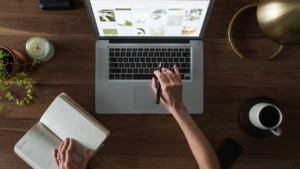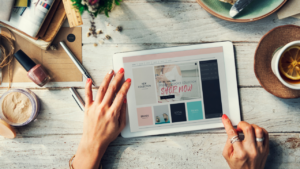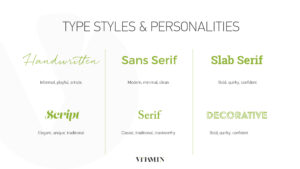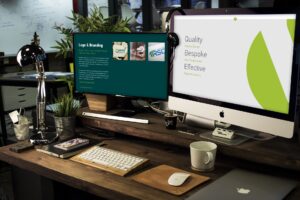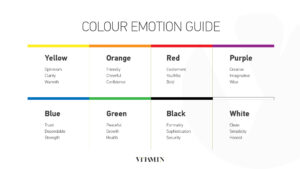Logo design is a major aspect of branding for all companies which acts as a key differentiator and primary identifier for firms operating within a crowded marketplace. A logo is described as a visual mark that represents your brand and is a tangible expression of what your business is about which helps to create a strong first impression in the mind of a consumer.
The logo design of your business helps to communicate the overall values, qualities, and personality of your business. Consumers are known to search for products/services of high quality and this must be communicated through every message that your business transmits whether that be through large online channels such as the company website or social media platforms, all the way through to possible visual identifiers such as the company logo.
The first interaction that a potential consumer has with your business could be through your logo and ensuring your logo design is of a high-quality standard can go a long way to inviting a consumer to follow up on their initial interest. Consumers tend to have a short attention span of only 8 seconds which leads them to make snap judgments based on the information that is available to them.
Therefore, creating a strong logo design can help a consumer create a positive association with your brand that will give you a greater competitive advantage and a reason for them to interact with your company over others. Similarly, if your logo design is coming across as unprofessional and cheap, it raises doubts in the mind of the consumer if the product and service offering will be of similar quality.
With this in mind, the process of creating the perfect logo for your business can take time and effort to ensure it is the perfect fit with your brand’s identity. To help you with this process we have created our list of the 5 key aspects to logo design:
1. Research
One of the crucial steps in logo design is doing your initial research. Taking the time out to gather all the information required can make the process of designing a logo much easier. Companies that do not have the resources available to conduct this research often end up using stock or poor quality materials that do not coincide with the overall message of the brand.
A good place to begin your research is by creating a clear definition of your brand which will allow you to design a logo that is more fitting with your values and ethos and narrow down the style of the logo which is suitable for your business needs. Ensuring that your logo fits with your brand identity is essential to helping the consumer understand what they can expect from your business and build that initial connection.
The next step of your research should look at what techniques of logo design have worked for similar companies in the past and what techniques should you stay away from. This will enable you to set potential design boundaries and give you a better understanding of where to begin. This process will also help you outline the strengths and weaknesses of your competitors’ logos and highlight certain elements that you can use to help you stand out from the crowd.
2. Target Audience
The next step in designing the perfect logo for your business is determining who is your company’s target audience and how does your logo communicate with them. The target audience for your company is the collective group of people that you are most likely to be selling your product or service to which can be decided by a vast majority of factors such as age, income, location, interests and so on.
Your logo is a symbol of your business and ensuring that its design is appealing to the average consumer will impact its overall chance of succeeding. If your logo design does not convey the right message to your target audience it could fail to peak their interests or in the worst-case scenario actively encourage them to stay away from your company.
The overall aim of logo design is to help connect your brand with the consumer. With this in mind, outlining certain characteristics about your average consumer and creating a buyer persona will help you understand what elements of logo design would be most suitable for use and what aspects you should stay clear of.
3. Typography
Typography or the type of font you use for your logo design is a crucial aspect of the designing process. If your typography is used correctly, it can help to create a personality to your logo which is likely to entice the consumer to interact. Logo designers often use various different types of typography to portray a specific characteristic, emotion, or value to their targeted audience.
According to the “Mehrabian Rule”, 93% of our communication with other individuals is non-verbal, further highlighting the importance that should be placed on each aspect of logo design. The human eye is highly susceptible to varying forms of fonts, styles, and typographies that companies use and this can trigger certain emotions that become associated with your brand and its personality.
Ultimately, the font that you decide to use for your company’s brand carries a significant meaning which translates through to your end customer. Therefore, deciding on the personality of your brand is key to this step as different font types hold various meanings and it is key that the correct type is paired with your brand to emanate the desired message.
4. Flexibility
One of the key aspects of logo design and in a certain way is an advantage of small businesses is the ability to remain flexible. The ability to see what aspects of your brand are working and what elements are not so successful and implementing the desired change to satisfy consumer needs is a major strength that must be taken advantage of within the digital space for these companies. Your logo is one of the most meaningful ways to how you interact with your consumers and making sure it has the ability to continuously translate your company’s message over a period of time is critical.
Here are some ways to judge if your logo will be able to keep up to speed with your business:
Sizing
This is where you must consider how your logo will be used and viewed by the target audience. A logo should be easily visible and identifiable no matter if it is embroidered onto the shirt of a uniform or part of an advertisement that is 100 metres away. This is known as scalability and is a key aspect in the logo design process as it helps to ensure that all your design elements are well balanced and create a sense of harmony when put together on your marketing materials.
Background
You must also consider the type of background that your logo will be most commonly viewed from. For example, a logo that works well on a light background may be impossible to see if the background becomes darker. For this reason, it is commonplace for businesses to design two variations of their logo to accommodate both cases.
Formatting
It can be almost impossible to create a logo design that is the perfect shape for every situation where the logo may be used. Similar to our above point of making two colour variations, it may also be useful to design both a horizontal and vertical design for your company logo to make it easier to use across your range of possible business activities.
Physical elements
While it is common for a designer to spend the majority of their time focusing on how your logo is portrayed in a digital environment, it is also important to take the time to research how your logo will translate in the physical world without the effects of different gradients or complicated images that can be used on a computer screen.
Taking the time to properly analyse these elements of your logo design will greatly benefit your overall branding strategy by creating a consistent visual language that is easy for your consumers to understand.
5. Colours
Similar to the type of typography that you select, choosing the colours that you will be using is an essential aspect of the logo design process as 84.7% of consumers cite colour as the main reason behind buying a particular product. Choosing the right colour for your logo can be a difficult task as you are trying to use either a single colour or even a combination to convey a message and evoke an emotion within the mind of your consumer.
It is important to remember that each colour carries different connotations and these can be both positive and negative. For example,
“Warm colours are associated with energy, brightness, and action, while cool colours are often identified with calm, peace, and serenity”
Making sure that the colour/colours you choose are complementary to your brand and work well in tandem will make the process of portraying your brand message that little bit easier.
The colours that you choose should help to make your logo design more recognisable and no matter if you choose one, two, or three colours, it will be hard to find that combination that will be universally adored by everyone and you should make your decision based on what works best for you and what you want to achieve.
We hope that you enjoyed our article and gained some insight into how to improve your logo design process.
Now that you have read our logo design considerations, why not take a look at some of our other articles here.
Do you need help with your logo or any aspect of your graphic design process? Contact us today to get your project started.

